Sun activity for June 30, 2023: Huge, beautiful prominence in the northeast
A huge, gorgeous prominence erupted over the back side of the northeast limb (edge). It occurred at around 19 UTC on June 29. SOHO‘s LASCO C2 captured the resulting coronal mass ejection (CME) as the planet Mercury entered the field of view (see image below). The CME is not Earth-directed, since the blast came from the far side of the sun. Sun activity reached moderate with the production of an M3.8 flare from AR3354. As it was a closed loop flare, scientists don’t expect an associated coronal mass ejection. Nevertheless, we will confirm this after experts finish their modeling and analysis of the event. After the blast, AR3351 faded out and disappeared. Stay with us for more sun news.
Last 24 hours: Sun activity is moderate with the production of an M3.8 flare by sunspot AR3354 at 14 UTC on June 29. Between 11 UTC yesterday and 11 UTC today, the sun produced 15 flares, one M and 14 Cs. The largest, the M3.8 flare, caused an R1 (minor) radio blackout over the North Atlantic Ocean, west of Canary Islands. Sunspot AR3354 continues to be the largest on the Earth-side of our star, and it kept its beta-gamma-delta magnetic configuration. Have you spotted it yet? If not, you still have a chance today. It’s so large that all you need to see it is eclipse glasses. Always wear the proper eye protection when you observe at the sun. AR3354 was the main flare producer during the past day with eight flares. The sun currently has five numbered active regions.
Sun activity for June 29, 2023: Will Solar Cycle 25 be stronger than forecast?
Sun activity has been low during the past day, with only C flares. Another low-flare day! Yet the peak of Solar Cycle 25 is only 1½ to 2 years away. Should we anticipate a mild peak for Solar Cycle 25, as many have suggested? Not necessarily. The truth is … Solar Cycle 25 is running ahead of predictions. In the graph above, you can see a comparison between Solar Cycles 24 and 25. The last solar cycle – a relatively mild cycle – had an overall maximum of 146 sunspots in February 2014. Meanwhile, Solar Cycle 25 reached nearly that level – 143 sunspots – in January 2023, two years ahead of its predicted peak in 2025. Solar Cycle 25 hasn’t yet reached the level of Solar Cycle 24 in terms of peak sunspot numbers. But events are clearly happening much more rapidly than forecast. So – despite the naysaying – it seems as if this solar cycle may be stronger than the last cycle. In fact, a group of solar scientists led by Scott McIntosh of NCAR (National Center for Atmospheric Research) has developed a new model. And the updated model is closer to the observations of Solar Cycle 25. It looks like we’re going to have a larger solar cycle than originally predicted! What’s more, its peak may be here at least a year earlier … See the graphic below. Exciting sun fun may be ahead! Stay tuned.
Last 24 hours: Sun activity is back to low levels. Only C flares were produced in the past day (11 UTC yesterday and 11 UTC today). There were a total of 14 C flares during the period. The largest was a C5.5 flare from sunspot AR3354 at 18:39 UTC on June 28, 2023. This sunspot, AR3354, continues as the lead flare producer. It produced six C flares and kept its beta-gamma-delta magnetic configuration. It is the largest sunspot on the Earth-facing side of the sun. In fact, you can see it without magnification using only eclipse glasses. Always wear the proper eye protection when you observe at the sun. Take a look and try to spot it. Let us know in the comments if you found it. The rest of the sunspots look tiny and are stable or in decay. The sun has eight numbered active regions with no newcomers today.
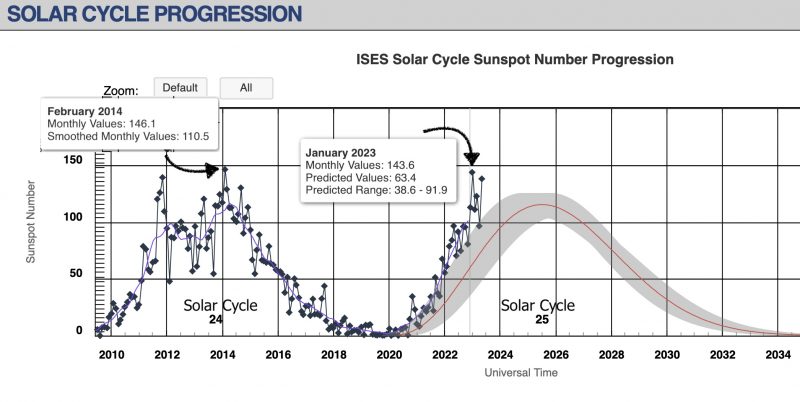
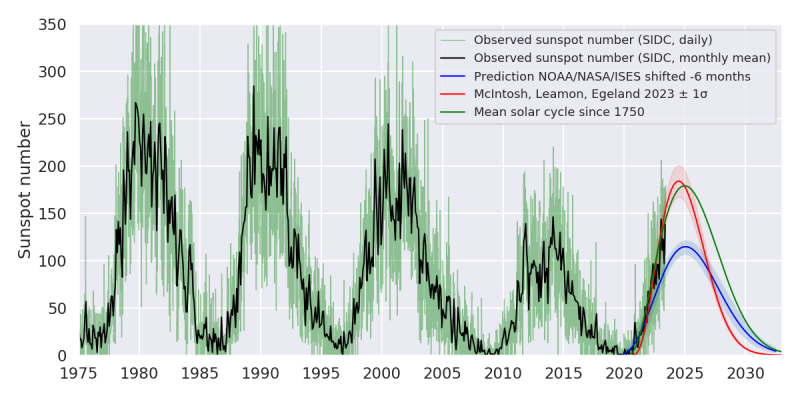
Sun activity for June 28, 2023: A glow is in the air
While sun activity continues at moderate, with two M flares fired over the past day, we have seen reports of airglow. Not to be confused with auroral displays, which are very well-structured and provoked by high speed solar wind, airglow is spread evenly over the sky and occurs when molecules of mostly oxygen and nitrogen are energized by ultraviolet (UV) radiation from the sunlight. As we approach the solar cycle’s maximum, we’ll be able to witness these events more frequently. Turning back to the sun, sunspot region AR3354 has shown substantial growth, developing spots and penumbra. It now shows a beta-gamma-delta magnetic configuration. That means it has the potential for Ms and even X flares. This active region has also become the lead flare producer of the past day. Get more details below.
Last 24 hours: Sun activity remains at moderate. Between 11 UTC yesterday and 11 UTC today, we saw two M flares and 18 Cs. The largest was an M1.9 flare at 8:44 UTC on June 28. The second largest was an M1.3 at 15:14 UTC on June 27. Both Ms were produced by sunspot AR3340. After each M flare, R1 (minor) radio blackouts were registered. The first occurred over the middle of the north Atlantic Ocean, and the second affected an area over the north of Saudi Arabia. While active region AR3340 remains the only M flare producer currently on the Earth-facing sun, AR3354 took over as lead producer of the day with nine flares. There is a newcomer in the sunspot neighborhood, now labeled AR3355. This makes a total of eight numbered sunspots on the Earth-facing side of our star.
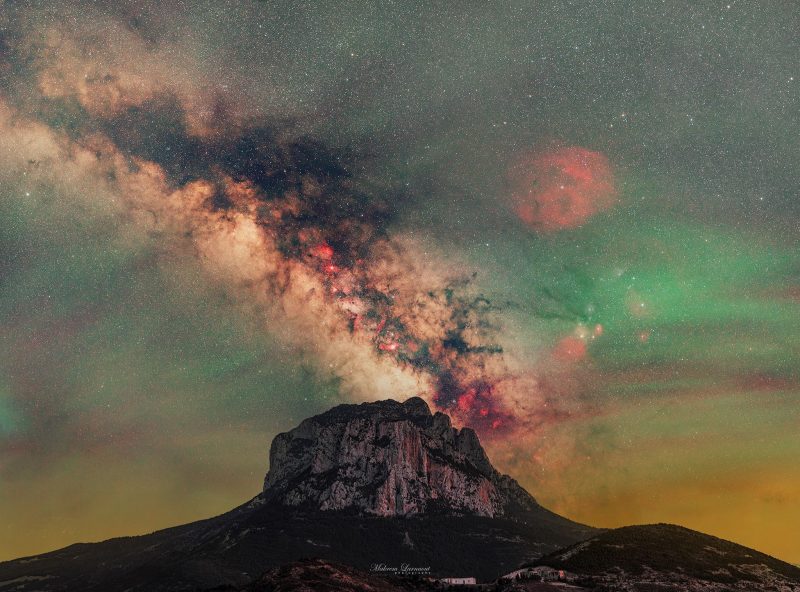
Sun activity for June 27, 2023: Mercury photobombs CME imagery
A slow filament eruption occurred at 11:51 UTC on June 26, with plasma lifting off from the northeast limb (edge). The LASCO C3 instrument aboard the SOHO spacecraft saw the resulting coronal mass ejection (CME). During this time, Mercury swung into view as it continued its orbit around the sun. After this filament eruption, a floating prominence danced on the northeast limb (edge). Some of it lifted off into space, and some rained back down onto the sun. Check it out in the imagery below!
Last 24 hours: Sun activity is moderate, with an M1.6 flare from active region AR3340 at 16:22 UTC on June 26. The M flare caused an R1 (minor) radio blackout that affected an area over the Atlantic Ocean, north of Puerto Rico. Eleven C flares occurred between 11 UTC yesterday and 11 UTC today. AR3340 produced eight of the 12 total flares, including the M1.6 flare. The region continues to be the largest sunspot on the Earth-facing side of the sun. It has lost its delta region, but still shows a beta-gamma magnetic complexity. The sun currently has eight sunspot regions, including newcomer AR3345.
Sun activity for June 26, 2023: Sunspot region ramping up
Although the sun has calmed over the past day, sunspot region AR3340 grew in size and complexity. It has formed a delta region, one of the indicators of potential M and X flares. Will it give us any large flares? It’s worth keeping an eye on this region. It produced more than half the flares over the past day (11 UTC June 25 to 11 UTC June 26, 2023). Meanwhile, another region – AR3341 – produced the largest flare, a C8.5, just shy of M-class size and the threshold for moderate activity.
Last 24 hours: Sun activity is now considered low, with only C-class flares. We saw a total of 23 flares between 11 UTC yesterday and 11 UTC today. As mentioned above, AR3341 created the largest event, a C8.5 at 12:03 UTC. AR3340 was the flare leader with 14 C flares. The number of sunspots groups on the sun’s Earth-facing side has dropped from 14 to seven. We’ve also continued to see prominence and filament activity.
Sun activity for June 25, 2023: A busy sun day, all around
No one thing stands out, but there’s a lot happening around the sun, and even here at home. It’s a small-scale taste of what can happen nearing solar maximum: lots of flares, filaments, and more. Sun activity is moderate thanks to an M1.1 flare from AR3337. We didn’t reach yesterday’s peak number of sunspot regions, 16, but today is pretty close with 14 visible on the disk. All of the regions are fairly small and simple but that could change quickly. We did see a bit of action at Earth. A coronal mass ejection (CME), possibly from last week’s X flare, brushed past Earth, leaving a disturbed geomagnetic field in its wake. This triggered a short bit of storming with a G1 geomagnetic storm around 16:00 UTC on June 24. Those levels have settled down but fast solar wind from some coronal holes may rattle it again in the next few days. There are numerous prominences and filaments around the solar disk. One erupted from the south pole around 4:00 UTC on June 25. There are a couple of prominences on the east limb (edge) and two notable filaments in the northern hemisphere including one with the classic sigmoid or S-shape structure. Within a sunspot this often indicates eruptive potential. Stay tuned!
Last 24 hours: Sun activity is moderate. We saw a total of 19 flares between 11 UTC yesterday and 11 UTC today. AR3337 brought activity levels to moderate with the release of an M1.1 flare at 12 UTC on June 24, 2023. AR3335 was the flare leader with eight C flares. The sun has 14 active regions on its Earth-facing side.
Sun activity for June 24, 2023: 16 sunspots! Most in 2023
Today’s top news: Sun activity is low. But the number of active regions – or sunspots – is high! We saw a peak of 16 sunspots earlier today, including five numbered newcomers. At the time of this writing (11 UTC, June 24) some of the 16 sunspots have rotated out of view on the sun’s west limb. Still, this number of sunspots is the highest so far this year. And it’ll surely increase the average monthly rate of sunspots for June 2023. Elsewhere on the sun, we saw filaments – ropes of solar material and magnetic fields – that produced jets as long as several Earths! They were in the sun’s northwest and southwest. None of the plasma they hurled was fired in Earth’s direction.
Last 24 hours: Sun activity is low. We saw a total of 19 flares between 11 UTC yesterday and 11 UTC today. AR3337 was the flare leader, with six C flares in total. This included a C4.1 flare at 9:19 UTC on June 24, the largest flare of the past day. Currently, the sun has 12 active regions on its Earth-facing side. This includes five newly-numbered regions: AR3345 on the northeast quadrant, AR3347 on the southwest, and AR3348, AR3349, AR3350 and AR3351 all coming across the east limb (edge).
Sun activity for June 23, 2023: X flare-producing region still going strong
The producer of June 20’s X flare, AR3341, remains the focus of sun activity. Today it released two M flares: an M4.9 and M1.1. It is now moving into a geoeffective position over the next few days, so any coronal mass ejections (CMEs) from the region may come our way. We’ll keep a close eye on this region! Elsewhere on the sun, we have observed erupting filaments in the southeast, jets in the southwest, and a stable prominence on the northeast limb (edge) over the past day. Some of the action beyond the eastern limb hints at more regions rotating into view soon.
Last 24 hours: Sun activity continues at moderate levels. A total of 18 flares were observed between 11 UTC yesterday and 11 UTC today: two Ms and 16 C flares. The largest flare was an M4.9 at 23:44 UTC on June 22 from AR3341. AR3341 also produced an M1.1 flare at 11:21 UTC earlier that day. This region, which produced the recent X1.1 flare, was the lead flare producer of the past day with the two Ms plus five Cs. Each M flare produced an R1 (minor) radio blackout. The blackout from the M4.9 flare affected an area over the Pacific Ocean east of Hawaii, and the M1.1 flare affected an area over the Sahara desert and north coast of Africa. The sun currently has 10 numbered active regions, with no newcomers.
Sun activity for June 22, 2023: Parker Solar Probe perihelion #16
Today, the Parker Solar Probe is at perihelion, its closest point to the sun. NASA launched this spacecraft on August 12, 2018, saying it was to be the first human spacecraft to “touch the sun.” By that, NASA meant the craft would get closer to our star than any human spacecraft ever has. And so the Parker Solar Probe has done, again and again. When the craft performs its closest approach to the sun today for the 16th time, it’ll be at a distance of around 5.58 million miles (~9 million km) from our star. It’ll be traveling at a speed of approximately 355,310 miles per hour (~571,000 km/hr). Read more about the mission here: Parker Solar Probe peers into coronal hole, sees source of solar wind.
Last 24 hours: Sun activity is moderate. There were two M flares between 11 UTC yesterday and 11 UTC today. Otherwise, we observed a dramatic reduction in flaring activity. There were only seven flares in the past day: the two mentioned M flares plus five Cs. That’s in contrast to 24 flares – including an X1.1 flare – the day before. The largest of the past day was an M1.1 by sunspot AR3341 at 12:44 UTC on June 21. The second largest was an M1.0 flare by AR3337 at 15:38 UTC on June 21. Shortly after the M flares, R1 (minor) radio blackouts were registered. The first affected an area over the northwest coast in Africa and the second over the Atlantic Ocean, east of Bermuda. The sun currently has 11 numbered active regions. There is a newcomer now numbered AR3346. It emerged over the equator, east of the central meridian.
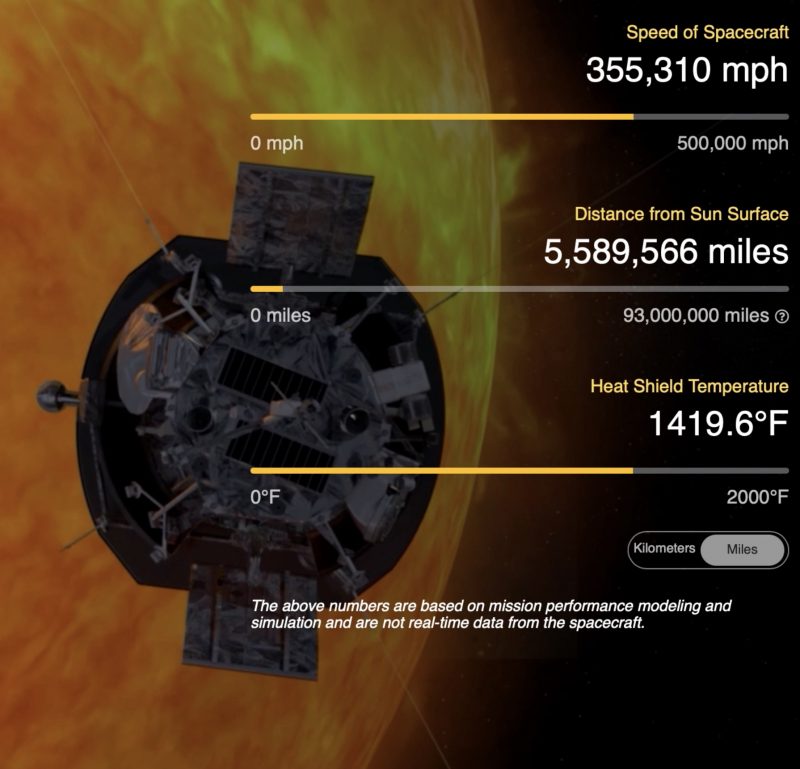

Sun activity for June 21, 2023: X flare!
Sun activity is now high, following the explosion late yesterday of an X1.1 flare. The strong blast happened on the sun’s southeast limb (edge) at 17:09 UTC on June 20. And it’s now been confirmed: the source was sunspot AR3341, which came into view as recently as June 19. A coronal mass ejection (CME) was produced during the event, which in turn caused an R3 (strong) radio blackout over an area of Florida. We’ve been waiting for this to happen, after a couple of weeks of a calm sun. We had not seen an X flare since March 29, 2023.
Last 24 hours: Sun activity increased to high with an X flare and four M flares during the past day. We observed an increase in total flares as well, with 24 flares between 11 UTC yesterday and 11 UTC today. There were 19 Cs, four Ms and one X flare. This is the breakdown of the X and M flares:
M1.1 at 11:13 on June 20 by AR3342
M1.8 at 11:25 on June 20 by AR3342
M1.0 at 15:48 on June 20 by AR3342
M1.1 at 16:33 on June 20 by AR3342
X1.1 at 17:09 on June 20 by AR3341, the largest.
AR3342 was the flare leader of the day. This sunspot kept flaring all day long. In the animation below, you can see the sequence of sparks from this active region. It produced a total of 14 flares during the period. It was the author of the 4 Ms of the day plus 10 Cs. Let’s see what this sunspot give us before it departs on the southwest limb. R1 (minor) radio blackouts were observed on the sunlit side of Earth after each M flare. As mentioned above, the X flare produced an R3 (strong) radio blackout over an area in Florida. There are two newcomers on the Earth-viewed side of the sun: AR3344 on the northwest quadrant, close to the limb (edge), and AR3345 on the northeast. The sun today is adorned with 9 numbered active regions as we close this writing. But, during the past day, it momentarily showed up to 12 labeled sunspots.
Sun activity update for June 20, 2023: Prominences on 4 quadrants
We frequently see long-lasting prominences on the sun’s limb (edge). They typically appear isolated on one solar quadrant or another, and it’s not common to see them in all four solar quadrants simultaneously. But that’s exactly what we did see on the sun’s Earth-facing disk during the past day. There were prominences on all four quadrants of the sun: northeast, northwest, southeast and southwest. Plus the sun produced an M flare! Details below.
Last 24 hours: Sun activity continues at moderate levels. Total flare production during the past day (11 UTC yesterday to 11 UTC today) was one M flare and 18 C flares. Sunspot region AR3341 produced the M1.2 flare at 12:14 UTC on June 19, 2023. After the blast, an R1 (minor) radio blackout occurred over Algeria’s north coast on the Mediterranean Sea. We have two new sunspot regions on the Earth-facing side of the sun today. AR3342 emerged on the southwest quadrant and rapidly became the lead flare producer of with five C flares. It is now located very close to the southwest limb (edge) and will soon rotate out of view. The second region, which is numbered AR3343, is located on the northwest quadrant. The sun has 10 labeled sunspot regions on its Earth-facing side.
Sun activity for June 19, 2023: 2 M flares, 2 Earth-facing coronal holes
The sun produced two M flares over the past day, with a coronal mass ejection (CME) from one of them. Details below. Two of the three coronal holes we reported yesterday, the ones on the southeast quadrant, are now geoffective, that is, capable of affecting Earth. So the fast solar wind they produce will come our way. Read about coronal holes as a source of the solar wind here.
Last 24 hours: Sun activity is now considered moderate. Of the past day’s two M flares, the largest was an M2.5 flare produced by sunspot AR3336 at 13:35 UTC on June 18, 2023. The second M happened at 3:50 UTC on June 19. It was an M1.4 from the sun’s southeast limb (edge), produced by an active region that’s just rotated into view and isn’t numbered yet. There were also 15 Cs, for a total of 17 flares produced during the past day. Lead flare producer of the day (11 UTC June 18 through 11 UTC June 19) was sunspot AR3335, with six C flares. After each M flare an R1 (minor) radio blackout was registered. The first was over the Atlantic Ocean, west of the Northern African coast. The second affected an area over an area on the east coast of China. The observable face of our sun shows eight labeled active regions today. We have a newcomer in the neighborhood, sunspot AR3340 which appeared on the sun’s northeast limb (edge).
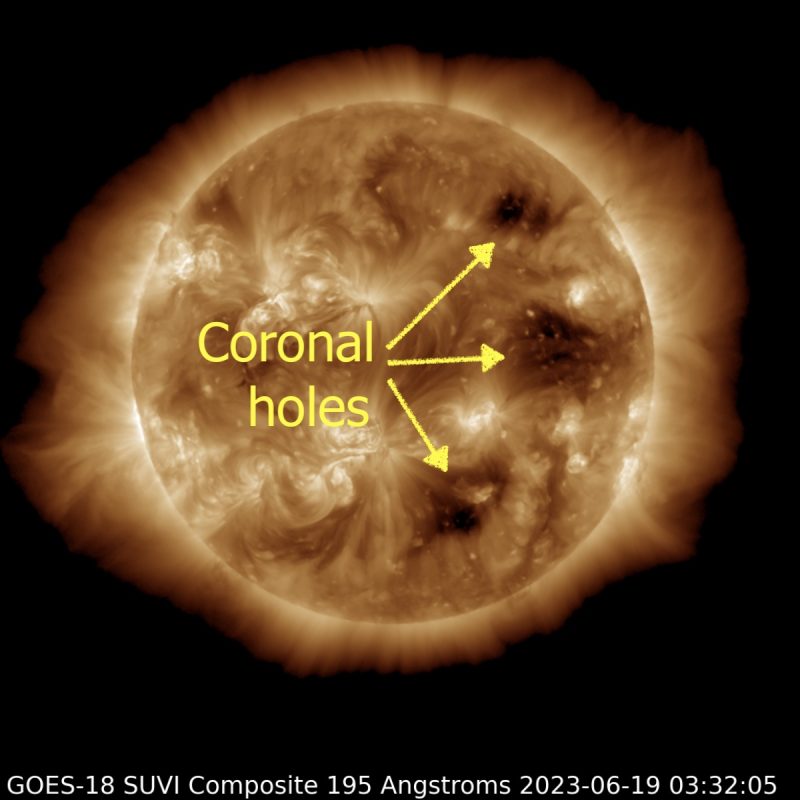
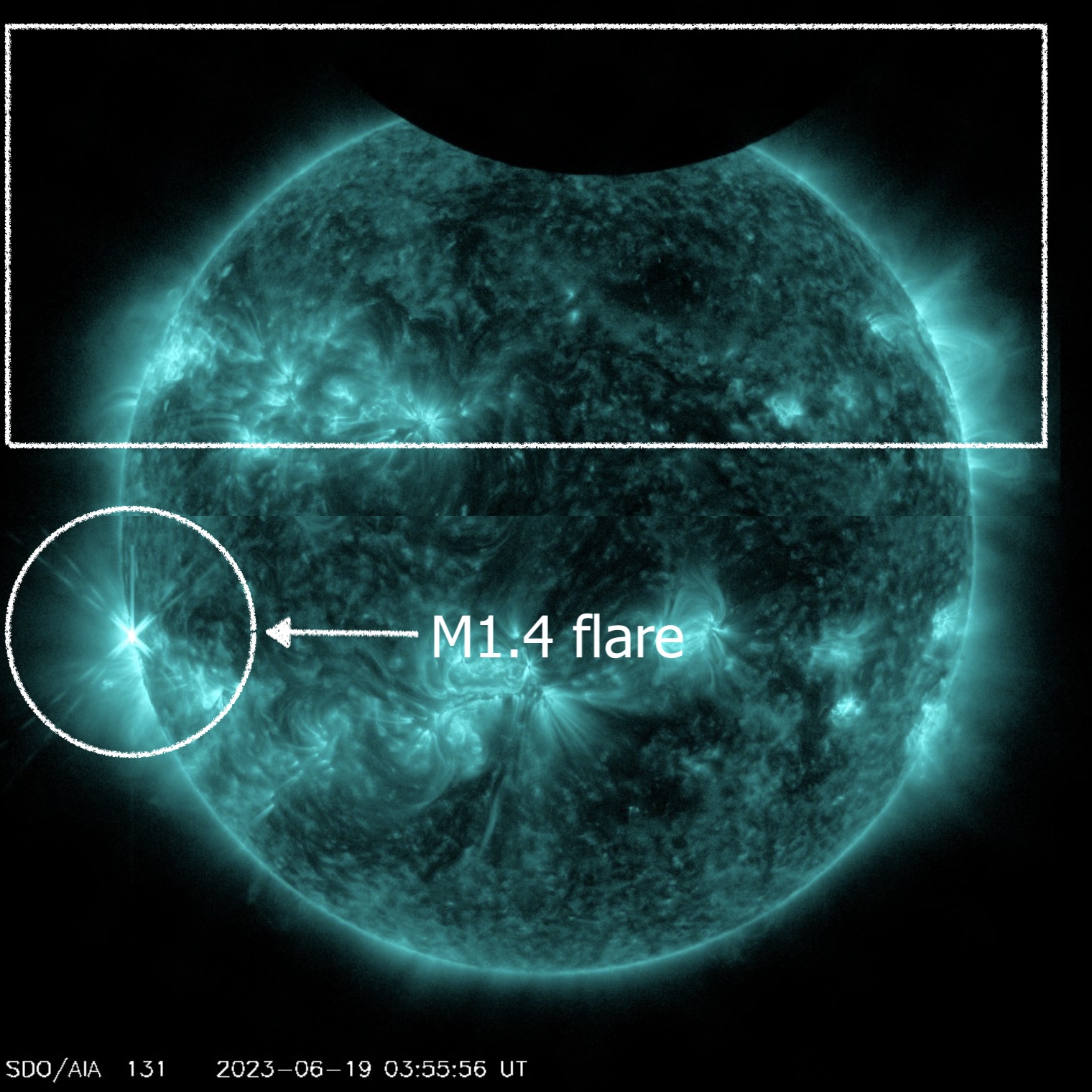
Sun activity for June 18, 2023: Action in the southeast
Most of sun activity during the past day (11 UTC yesterday to 11 UTC today) happened on the sun’s southeast quadrant. We saw mostly C flares and an M1.3. As we closed this writing, we saw a double prominence, one and two, exploded by an active region on the sun’s far side, depicted in the image above. Elsewhere on the sun, three large coronal holes adorn our star on its Earth-side. Two coronal holes are on the northwest quadrant. And one is in the sun’s southern hemisphere, just above the central meridian. So there are chances for more sun fun as these coronal holes – carried by the sun’s rotation – move into a more geoffective position. Read about coronal holes as a source of the solar wind. And stay with us for more sun news.
Last 24 hours: Sun activity continues to be moderate. Sunspot AR3336 produced an M1.3 flare, the largest of the day. The blast occurred at 0:31 UTC on June 18, 2023. The total flaring production of the past day was 17 flares; 16 Cs and the abovementioned M flare. Our observation period is from 11 UTC yesterday to 11 UTC today. Shortly after the M flare an R1 (minor) radio blackout was registered affecting an area over the Pacific Ocean west of the Hawaiian islands. The sun has six numbered active regions on its Earth-viewed side, including a newcomer, AR3339, that came into view on the southeast limb (edge).
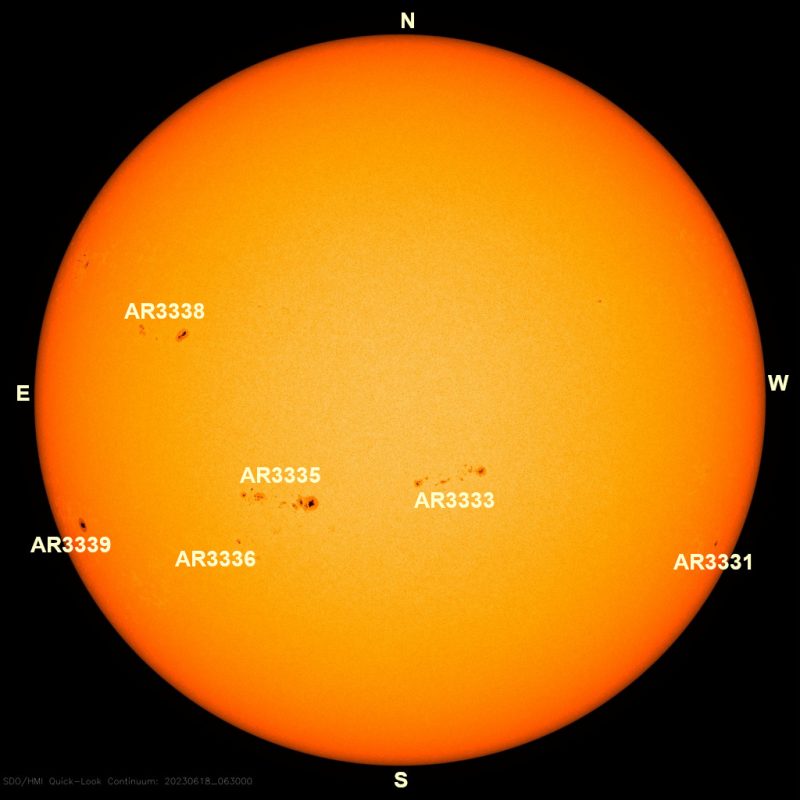
Sun activity for June 17, 2023: Both Earth and sun calmer today
After yesterday’s excitement at Earth and on the sun, both have calmed down. First, Earth. Our geomagnetic field is now at quiet levels. Did you see auroras overnight on June 15-16? Auroral displays were observed from Alaska to New Zealand. But things were calmer last night. There might be some action in the geomagnetic field today. But no geomagnetic storms are on the horizon. Meanwhile, sun activity has stayed moderate due to an M1.0 flare. It wasn’t a super active start to the day today. But the day is young (11 UTC on June 17 at this writing), so stay tuned.
Last 24 hours: Sun activity is moderate. During the past day, the sun produced 10 flares, nine C and one M. The largest flare was an M1.0 from AR3331 at 19:52 UTC on June 16. The M flare caused a radio blackout on the sun-facing side of Earth. The sun has seven numbered active regions.
Sun activity for June 16, 2023: Excitement on both sun and Earth
After several days of low sun activity, levels have now jumped to moderate, with several M flares popping off earlier today (including one at the time of this writing; details below). Plus! Here on Earth, we reached the minor geomagnetic storm threshold at 21 UTC on June 15. Did anybody see auroras? Let us know in the comments below. Last night’s geomagnetic storm has nothing to do with the M flares. It takes a few days for activity on the sun to travel to us. Instead, the geomagnetic storm was due to the arrival of what’s called a co-rotating interaction region (CIR). The geomagnetic field oscillated between G1 (minor) and G2 (moderate) levels into early June 16 (last night in the U.S.). The storming has since subsided, but remains active at the time of this writing. So the sun appears to be picking up. Signs point to more to come (maybe)! Stay tuned.
Last 24 hours: Sun activity is now moderate. During the past day, the sun produced 13 flares, 11 C and three M. The largest flare was an M1.1 from AR3338 at 10:20 UTC on June 16, 2023. We also had an M1.0 from AR3337 at 5:21 UTC on June 16, 2023. And we just had another M1.1 flare from AR3338 (at the time of this writing). And there was almost an M with a C9.7 from AR3336 at12:33 UTC on June 15, 2023. The first two M flares caused radio blackouts on the sun facing side of Earth. The sun has eight numbered active regions.

Sun activity for June 15, 2023: Action incoming from the east
Today’s top news: Like Earth, the sun rotates counter-clockwise, as viewed from earthly north. So the sun’s east quadrant is the one just now rotating into view. And we could see over the past day that it is, perhaps, bringing on more action. We saw prominence eruptions from behind the sun’s limb (edge) on the northeast. This northeast action has now lasted for two days, but soon this region will rotate into view! The southeast also brought us two new active regions today, including the primary flare producer today, now numbered AR3335. This was also the main flaring region yesterday. We will keep an eye on this sunspot. Stay tuned.
Last 24 hours: Sun activity continues at a low level. During the past day, from 11 UTC yesterday to 11 UTC, the sun produced 20 C flares. The largest flare was a C6.7 from AR3327 at 22:59 UTC on June 14, 2023. Newcomer AR3335 was the lead flare producer. It produced eight of the period’s C flares. The sun has seven numbered active regions. This includes the two newcomers, AR3335 and AR3336, in the southeast quadrant.
Sun activity for June 14, 2023: Higher activity might be on its way
Hopefully, action is on its way from our sun’s east limb (edge). An incoming active region on the northeast limb blasted the largest flare of the day: a C6.3. When this was fired the newcomer region did not have a number, as it was located at the very edge of the solar disk. Now that it has arrived fully into view, the region has been labeled AR3334. In the meantime, another region that might have produced a prominence yesterday has become today’s lead flaring producer. It does not have a number yet, but it has already produced 15 C flares between 11 UTC yesterday and 11 UTC today. It seems more action is coming our way! Stay with us for more sun news.
Last 24 hours: Sun activity is low with only C flares, but it is increasing. From 11 UTC yesterday to 11 UTC today the sun produced 25 C flares. A C6.3 flare was the largest. It was produced by a newcomer on the northeast, AR3334, at 17:38 UTC on June 13. An as-yet-unnumbered active region on the southeast limb is the lead flare producer of the day, with 15 of the 25 C flares. There are two labeled newcomers on the Earth-facing solar disk: AR334, as mentioned above, and AR3333, which emerged on the southeast quadrant. The sun currently has six sunspot regions on the its Earth-facing side.
Read more: Parker Solar Probe peers into coronal hole, sees source of solar wind.
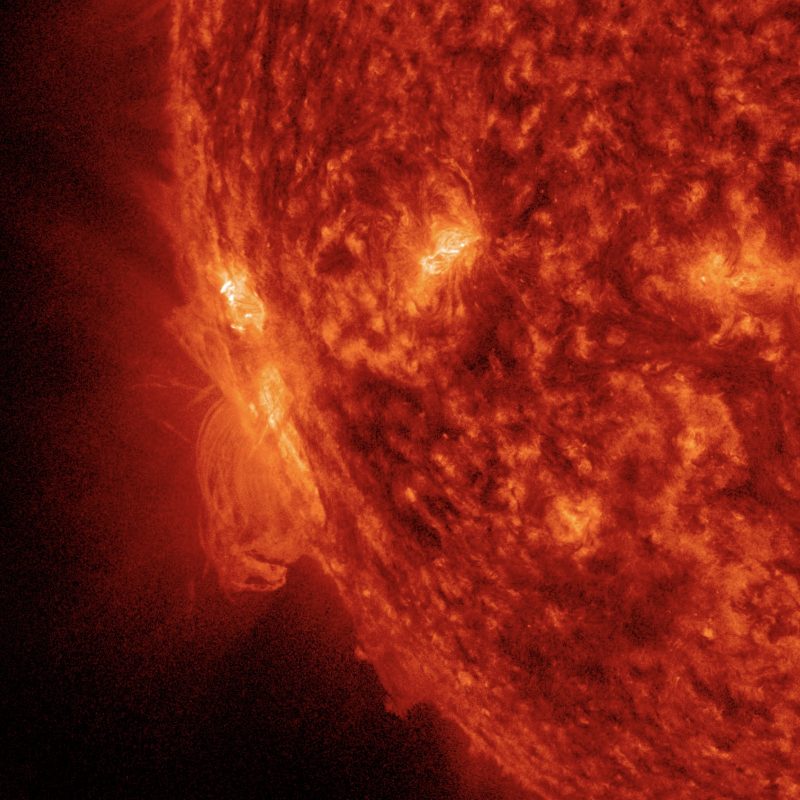
Sun activity for June 13, 2023: A solar deja vu, all over again
Deja vu. Sun activity remains low but similar to yesterday’s massive filament eruption; another one left the north pole area around 1 UTC, June 13, 2023. The prominence grew for a couple of hours until it released solar plasma (super-hot gas) into space. The resulting coronal mass ejection (CME) is probably not Earth-directed. We also saw long lasting prominences on the east, north and south of the solar equator. That may indicate active regions beyond the limb (edge) coming our way. Stay tuned.
Last 24 hours: Sun activity remains at low levels. Flare production from 11 UTC yesterday to 11 UTC today was 15 C flares. The largest solar explosion was a C5.1 by AR3327 at 23:27 UTC on June 12. AR3327 was the lead flare producer with four C flares. The sun has five sunspot regions on its Earth-facing side.
Sun activity for June 12, 2023: Massive filament from sun’s north pole
Sun activity today is low. But you wouldn’t know it looking at the sun’s north pole. A massive filament erupted, sending a huge cloud of solar plasma (super-hot gas) barreling away from the sun at millions of miles per hour. The eruption rose away from the sun’s surface – becoming a prominence (the name for a filament observed off the sun’s limb, or edge) – starting around 1:52 UTC on June 12, 2023. It continued its swift rise until it was no longer held down by the sun’s magnetic fields. That’s when it lifted off into space. Given the direction of the hot gas as it hurtled into space – almost entirely northward – the resulting coronal mass ejection (CME) doesn’t have an Earth-directed component. Stay tuned for more sun news!
Last 24 hours: Sun activity is low. A total of 13 flares were observed from 11 UTC yesterday and 11 UTC today. There are no M flares which keeps the activity level as low. The largest observed flare was a C5.2 at 6:49 UTC on June 12, from AR3330. The sun currently has five sunspot regions on its Earth-facing side.
Sun activity for June 11, 2023: It’s a calm sun day
Sun activity today has dropped to low. We’ve observed only C flares over the past 24 hours. Relatively speaking, it’s a quiet sun day on this Sunday, as we wait to see what any regions that haven’t yet rotated into view might have to offer. AR3332 has been doing most of the flaring, making it up to a C5.7. Maybe the region still has a little gas in the tank left for some last-minute excitement. But don’t let the calm fool you. It’s surely just a short lull. Soon we will see more obvious signs of our continued rise toward solar maximum. Stay tuned!
Last 24 hours: Sun activity is low. A total of 11 flares were observed from 11 UTC yesterday and 11 UTC today. That’s a few more flares than the day before, but no M flares this time. So the activity is described as low. The largest observed flare was a C5.7 at 21:10 UTC on June 10, from AR3332. The sun currently has eight sunspot regions on its Earth-facing side.
Sun activity for June 10, 2023: An M flare and 2 CMEs!
Sun activity today has risen to moderate, thanks to a surprise M2.5 flare from AR3331. This flare produced one of two coronal mass ejections (CMEs) observed over the past day. The other came from a filament eruption on June 8, which was determined to have a slight Earth-bound component which should reach us on June 11. The two coronal holes we mentioned yesterday have begun to decay, but another one has developed in the northeast. We’ll keep watching.
Last 24 hours: Sun activity is moderate. A total of eight flares were observed during the period between 11 UTC yesterday and 11 UTC today. That’s fewer flares overall than yesterday, when sun activity was described as low. And today we’re saying the activity level has risen to moderate. Why? It’s because the M flare threshold was reached. AR3331 made that possible when it fired off an M2.5 flare at 17:11 UTC on June 9. Shortly after the M flare, an R1 (minor) radio blackout affected an area over the Gulf of Mexico. The lead flare producer of the day was sunspot AR3332, with four out of the eight flares. Yes, that means AR3327 has lost its crown after six days in a row as the most active region. It also lost its delta region over the past day. Poor AR3327! The sun currently has eight sunspot regions on its Earth-viewed side.
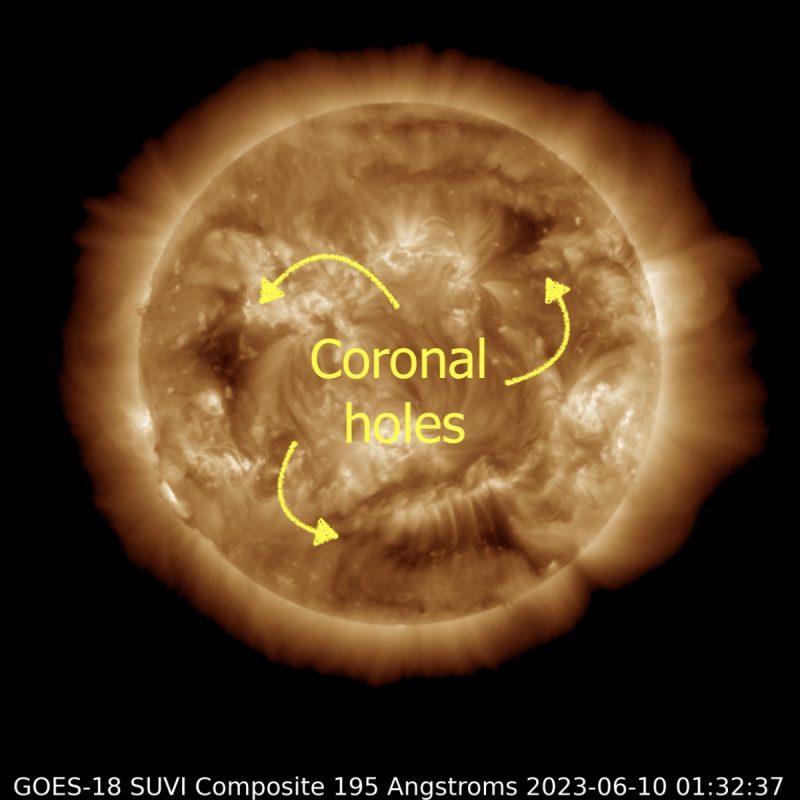
Sun activity for June 9, 2023: Incoming sunspots, active solar periphery
Although sun activity has returned to low, the periphery of our star is looking busy. Jets, exploding filaments and prominences can be seen all around the solar horizon. Plus, helioseismology shows many large sunspots on the far side of the sun, soon to rotate into view. So activity is coming our way. Here on Earth, the coronal mass ejection (CME) from June 4 passed close to us, but it did not bring much turbulence to our planet’s magnetic field and, presumably, auroral displays were minimal. Tell us what you saw in the comments of this post!
Last 24 hours: Sun activity is back to low. The sun produced only 10 faint C flares between 11 UTC yesterday and 11 UTC today. The largest was a C2.2 flare, fired at 0:07 UTC by AR3327. This sunspot continues to be the leading flare producer, blasting out six out of the day’s 10 flares. The sun has nine active regions today, including newcomer AR3332, which has appeared on the sun’s southeast limb (edge).
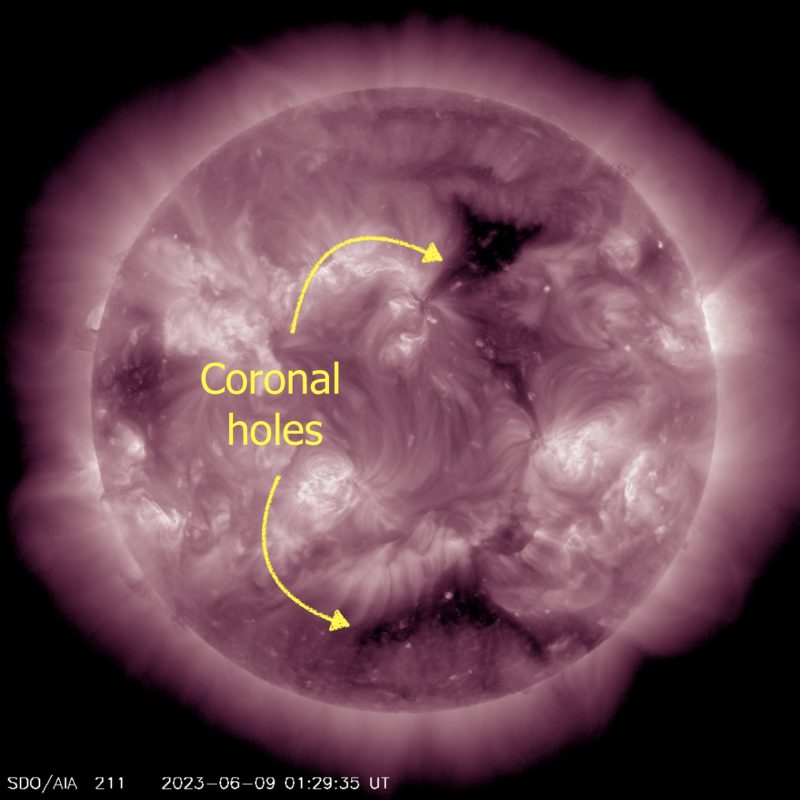
June 8, 2023: Flaring picks up to moderate
Sun activity has picked up – and is now considered moderate – with sunspot region AR3327 releasing a near-M5 flare. This region continues to be the most complex and active on the sun, with its delta region indicating the potential for M and even X flares. What will AR3327 bring next? Meanwhile, we’re watching the limb (edge) of the sun for a plethora of prominences. These filaments of solar plasma from lower down in the sun’s atmosphere are supported high up in the sun’s corona (outer atmosphere). They’re currently creating a unique dance display on our sun. We also await a possible glancing blow today from a coronal mass ejection (CME) launched into space on June 4. Read more under “current geomagnetic activity” below.
Last 24 hours: Sun activity is moderate, with one M flare plus 18 Cs during the past day (11 UTC yesterday to 11 UTC today). The largest was an M4.7 flare at 11:46 UTC on June 7 from sunspot AR3327. No surprise that this region continues to be the lead flare producer, with 11 flares including the M. Since it came into view, AR3327 has been the leader five days in a row. It has kept its beta-gamma-delta magnetic complexity, with a noticeable increase in both level and productivity due to this. Keep on going, AR3327! We’re having fun watching you. The M flare produced an R1 (minor) radio blackout in an area over northwest Africa. Today the sun has nine labeled sunspots, with newcomer AR3331 coming into view on the southeast limb.
Sun activity for June 7, 2023: CME arrival delayed, 2 more CME blasts
The coronal mass ejection (CME) from June 4 might still give us a glancing blow, but the CME arrival has been delayed. Experts are now expecting it later on June 8, bringing unsettled-to-active conditions whose effects might linger through June 9. Meanwhile, on the sun, over the past day we’ve seen two big explosions that hurled ejecta into space. The most recent blast occurred on the sun’s southeast quadrant at 6:12 UTC on June 7. See it in our top image. A C7.3 flare was associated with this explosion. The ejecta came from the vicinity of sunspot AR3327, which, by the way, has just developed a beta-gamma-delta configuration (the more complex magnetic configurations indicate a potential for increased flaring). The second blast occurred on the sun’s northeast quadrant, where SOHO’s LASCO C3 registered a CME ending at around 16:06 UTC on June 6. Neither of the CMEs were Earth-oriented. But note that these two active regions are moving westward on the Earth-facing side of the sun. That means that, in a few days, they’ll be located at a more geoffective position – a position more capable of affecting Earth – so they might start sending their solar material our way. We’ll keep an eye out!
Last 24 hours: Sun activity remains low, with only nine C flares produced between 11 UTC yesterday and 11 UTC today. AR3327 is again the day’s leading flare producer for the fourth day in a row. This time it produced seven flares, including the two largest of the period: a C7.5 at 19:00 UTC on June 6, and the C7.3 mentioned above. Two sunspots have shown notable growth: AR3327 is now showing a beta-gamma-delta magnetic complexity, and AR3323 has developed to beta-gamma. Today the sun bears eight labeled active regions.
Sun activity for June 6, 2023: Confirmed CME arrival overnight June 7-8
It’s now confirmed that the coronal mass ejection (CME) we’re expecting will arrive early on June 8 (overnight on June 7-8 for western Europe and the Americas). The sun hurled the CME into space on June 4, via an exploding filament on its southwest limb (edge). A component of this CME will give Earth a glancing blow, perhaps bringing G1 (minor) geomagnetic conditions and resulting auroras. So we are waiting … waiting … while the sun itself, for now, is exhibiting only low-level flaring. All the sunspots on the Earth-side of our star are stable, or in decay.
Last 24 hours: Sun activity is low. Over the past day, we saw only faint C flares: 11 in total. The largest flare of the past day (11 UTC yesterday to 11 UTC today) was a C6.3, sparked by AR3327 at 9:14 UTC on June 6. Yesterday we welcomed AR3327 as a newcomer and the lead flare producer. And today it continues leading for the third day in a row, with 6 flares. There are seven labeled active regions on the Earth-viewed side of the sun now, with AR3328 being today’s newcomer.
Sun activity for June 5, 2023: CME on its way, possible arrival June 7
Everybody’s talking about yesterday’s filament eruption on the southwest solar quadrant. As we reported on June 4, it hurled a coronal mass ejection (CME) into space. And a portion of the CME is coming our way. Preliminary analysis suggests a CME glancing blow by June 7, 2023. But do note that specialists still are working on further modeling and analysis of the event. The SOHO spacecraft’s LASCO C2 imager registered the blast at around 11:12 UTC. Then the LASCO C3 imager registered a partial halo one the southwest at around 12 UTC, a sign that a CME might be headed toward Earth.
Last 24 hours: Sun activity keeps to low levels. There were only C flares produced during the past day, from 11 UTC yesterday to 11 UTC today. Total production of the period was 15 flares with the largest being a C5.8 flare by active region AR3327. It was blasted out on the southeast limb (edge) at 14:30 UTC on June 4, 2023. AR3327 was also the most active sunspot of the past day. It contributed with eight flares. This same active region was yesterday’s hero, too, when it had not been numbered yet. It is now being carried more fully into view by the sun’s rotation. Welcome, AR3327! Currently the sun bears seven labeled active regions on its Earth-facing side.
Sun activity for June 4, 2023: BAM! Big blast on the southeast
Today’s top news: The sun produced an enormous and mesmerizing prominence on its southeast limb (edge) earlier today. The blast happened at around 2:24 UTC on June 4, 2023. And it came on a day when sun activity overall has been low. So … hello! Still, the prominence isn’t a surprise. This area on the sun’s southeast limb produced multiple C flares during the past day. And a C3.0 flare that happened at around 2:12 UTC on June 4 – just 12 minutes before the prominence – is perhaps associated with this impressive explosion. It can be seen the blast comes from beyond the solar horizon, from an active region that isn’t visible yet. But it’ll soon rotate into view. Also … this just in! Just before closing out today’s edition, the sun’s southwest responded back to the southeast, with a big filament eruption on the sun’s southwest quadrant. On the imagery below, you can see a big blast of ejecta hurtling into space from the event. Cool!
Last 24 hours: Sun activity is low. There were 19 C flares produced during the past day, from 11 UTC yesterday to 11 UTC today. The biggest was a C8.9 flare blasted by sunspot AR3323 at 3:49 UTC on June 4, 2023. Active region AR3319, and the incoming active region on the southeast limb (as yet unnumbered), share the position as lead flare producer. Each of these regions produced 5 flares. There are currently six numbered active regions on the Earth-viewed side of the sun.
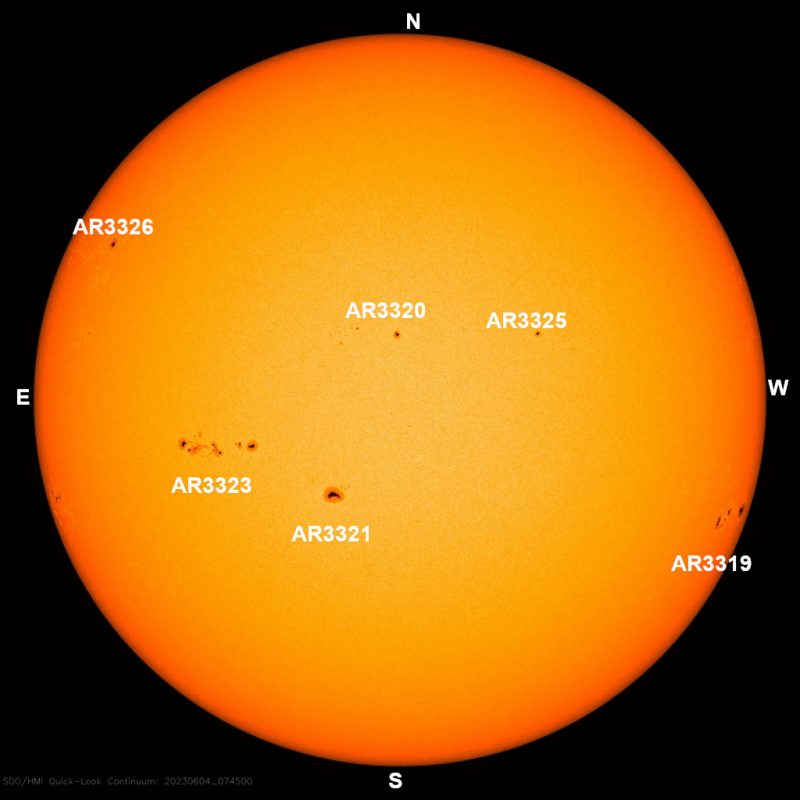
Sun activity for June 3, 2023: Departing sunspots put on a show
Today’s top news: Yesterday, we saw an increase in the likelihood of M and X flares. But, in the past day, sun activity has returned to low. Still … there’s some beautiful action in the northwest. AR3318 is about to depart, while AR3313 and AR3322 have just passed out sight behind the northwest limb (edge). As they continued to flare from beyond the horizon, we were treated to some lovely prominences. In fact, one was so lovely we could have sworn it was heart-shaped! See for yourself in the top animation. We also have to say farewell to the giant sunspot AR3315, which has now passed beyond the southwest limb. It hasn’t left the southwest totally quiet, though, as AR3319 is still blasting jets and hurling ejecta into space.
Last 24 hours: Activity is low with only C class flares. As well as a drop in flaring level, flaring productivity has also reduced over the past day: we only saw 10 C flares between 11 UTC yesterday and 11 UTC today. The largest was a C6.3 flare blasted at 22:42 UTC on June 2 by AR3323. This sunspot was the lead flare producer of the past 24 hours, with six out of the 10 flares. Yesterday’s newcomer has been numbered AR3324, as expected. And we have two more newcomers today. A sunspot on the central meridian, just north of the equator, has been labeled AR3325. And an active region that appeared on the northeast limb (edge) has been numbered AR3326. There are currently eight numbered active regions on the earth-viewed solar disk.
Sun activity for June 2, 2023: M flare in northwest, fiery action in southwest
It took a faint M1.5 flare in the northwest to keep activity levels at moderate today. But despite low flaring overall, we observed much activity on the Earth-viewed solar disk. The southwest quadrant continues to attract our attention, with fiery exploding filaments and prominences. Check out the imagery above. And look below to see a flare that was fired on the northwest limb (edge) at around 19 UTC, June 1. It was produced beyond the solar horizon, but was bright enough to still produce a flash. While we’ve seen fairly low flaring intensity and productivity over the past day, specialists are predicting action – notice the increase in chances for an M and X flare in the coming day. Stay tuned!
Last 24 hours: Activity is moderate, with one M flare and 14 C flares produced between 11 UTC yesterday and 11 UTC today. The one M flare of the period was an M1.5, which occurred at 2:41 UTC on June 2. It was produced by a newcomer sunspot that emerged from nowhere on the northwest quadrant, and will likely soon be numbered AR3324. The blast produced an R1 (minor) radio blackout that affected an area south of Japan over Okinawa Island. AR3323 was the day’s leading flare producer, with seven of the 15 flares. There are currently eight numbered active regions on the Earth-facing side of our star. The newcomer on the northwest quadrant is waiting to be numbered.
Sun activity for June 1, 2023: Newcomer sunspot is today’s flare leader
The newcomer sunspot region, AR3323 in the sun’s southeast, rapidly became the lead flare producer of the past day. It has been blasting C flares since it was still beyond the solar limb (edge). As soon as it came into view, it released two M flares, including an M4.3 flare (the last M flare of May). AR3323 first appeared with a beta configuration and in less than a day went up to a beta-gamma magnetic configuration. Bigger sunspots tend to be more complex magnetically, and often get a beta, beta-gamma or even beta-gamma-delta classification. Speaking of which … the sunspot we mentioned yesterday in the sun’s southwest quadrant, AR3319 – which was blasting flares and sending ejecta into space – has now developed a delta region. So it now bears a beta-gamma-delta magnetic complexity, suggesting it now has the potential for more M flares and X flares. It is also now geoeffective, which means that any forthcoming coronal mass ejections (CMEs) from this region might affect Earth, bringing us auroral displays.
Last 24 hours: Sun activity is moderate. During the past day, between 11 UTC yesterday and 11 UTC today, there were three M flares and 13 C flares. The largest event of the day was from AR3323, an M4.3 at 22:52 UTC on May 31, 2023. Shortly after, an R1 (minor) radio blackout effected an area over Hawaii. AR3323 was the lead flare producer with 10 total flares during the period. Today, the sun has nine sunspot regions on its Earth-facing side.
Bottom line: Sun activity archive for June 2023. A daily record of flaring, and other sorts of activity, on our local star.











